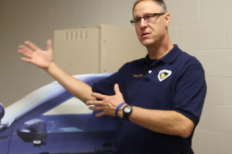






Following nationwide outrage with police officers using excessive or deadly force, one of the concerns from community members and experts is officer training.
A former police officer and current scholar researching policing, Seth Stoughton described the atmosphere of training as one that heavily emphasizes officer safety in an article in The Atlantic. Rookie officers are taught the “first rule of law enforcement”: an officer’s main goal is to go home at the end of their shift.
This emphasis, Stoughton believes, is too heavy as “Officers are trained to shoot before a threat is fully realized, to not wait until the last minute because the last minute may be too late.”
The Madison Police training center uses a training simulator that aims to condition officers to reason through what they would do in different scenarios and not to fear for their life and shoot.
Sergeant Linda Covert of the Madison Police Training Team helps officers understand and practice the best response to these life-like simulations.
“If they didn’t do well, we’ll put them through the recap and the same scenario again so they can do it right,” Sgt. Covert said.
Captain Joe Balles of the Madison Police Department’s South District and restorative justice program said the simulators are tools to help officers practice their decision-making.
“We can train officers and give them all sorts of policies and procedures, but until you’re actually in that scenario, you don’t really know how you’re going to respond,” Capt. Balles said.
The Madison Police Department calls it “Shoot – Don’t Shoot Training,” and one of the goals for officers is to learn how to de-escalate a situation before using excessive force. Many of the scenarios involve talking through what the officer would say in certain scenarios.
Officer Robert Veatch of the Madison Police Training Team said most of the scenarios require the officer to respond to the simulation verbally, not using a gun at all. This is designed to be representative of the work police officers encounter on a day-to-day basis.
“Not every scenario is a case of deadly force because this is unrealistic,” Officer Veatch said. “This is a safe way to [train] but it puts officers as close to realistic situations as possible.”
 In the video above, Officer Veatch explains the different scenarios used in the simulator. (Melissa Behling/Madison Commons)
In the video above, Officer Veatch explains the different scenarios used in the simulator. (Melissa Behling/Madison Commons)
To make the scenario feel close to reality, the simulator shows video in real settings with live actors as opposed to a computerized video game that would feel more artificial.
“If you get shot in a game, you just start over,” Sgt. Covert said. “In real life it’s a whole different story.”
For millennials who make up most of the new hires to police departments across the country, it is important to differentiate between training and video games. This generation has grown up playing video games with highly sophisticated graphics.
Capt. Joe Balles said it is important to research how the younger generation’s upbringing in a culture of violent video games can affect their decision-making on the street.
Right now MPD asks about an individual’s gaming habits in the hiring process.
“We are asking potential new hires how much time they spend in front of the screen,” he said. “That’s the pool five-to-ten years from now where officers will be looking to hire police officers.”
Mean World Syndrome, in mass media research is a theory that high-frequency television causes viewers to be exposed to more violence and therefore believe the world is more dangerous than it actually is. Young police officers may have different instincts out on the streets compared to more seasoned officers who have not grown up in this environment.
In cases of officers using deadly force, the justification is often that the officer felt threatened or genuinely believed their life to be in danger. This fear could come from an officer’s implicit bias, from the culture or police training or a host of other factors.
Right now the national discussion is focused on how to reform training and change the far-reaching implications of the criminal justice system in America. The nationwide outrage with too many black lives being taken from police officers using deadly force is increasing and researchers continue questioning how this keeps happening.
“People don’t realize how fast it happens,” Sgt. Covert said. “It’s easy to sit and watch from your couch, pause and rewind. But in real life you can shoot 10 rounds in two seconds.”
|
|
|
Welcome to the Madison Commons, a website designed to provide news and information about all of Madison's neighborhoods and a crossroads for the discussion of community issues. The name comes from the idea of a village commons, a place for news, talk, debate, and some entertainment, too, that's open to everyone.
All rights reserved. Read more about the Madison Commons and its partners.

